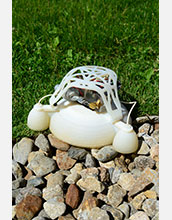

Harvard University engineers have developed one of the first 3-D printed, soft robots that moves autonomously.
Traditional industrial robots are rigid, mostly metal and fast, precise and powerful. But their speed and precision comes at the cost of complexity and can often pose a danger to humans who get too close. Soft robots are adaptable and resilient but slow, difficult to fabricate, and challenging to make autonomous because most motors, pumps, batteries, sensors and microcontrollers are rigid.
Harvard's soft robot's design offers a new solution to an engineering challenge that has plagued soft robotics: the integration of rigid and soft materials.
The robots body transitions from soft to hard, reducing the stress where the rigid electronic components join the body and increasing the robots resiliency. The bodys monolithic design--created in one continuous print job using several different materials--increases its strength and robustness. With no sliding parts or traditional joints, the robot isnt victim to dirt or debris like its more intricate cousins, making it a good candidate for use in harsh terrains.
The robots jumping ability and soft body would come in handy in harsh and unpredictable environments or disaster situations, allowing it to survive large falls and other unexpected situations.
This research was supported in part by a grant from the National Science Foundation (NSF) (grant DMR 1420570).
To learn more, see the NSF News From the Field story Hopping towards a better soft robot. (Date of Image: 2015) Credit: Harvard Microrobotics Lab General Restrictions:
Images and other media in the National Science Foundation Multimedia Gallery are available for use in print and electronic material by NSF employees, members of the media, university staff, teachers and the general public. All media in the gallery are intended for personal, educational and nonprofit/non-commercial use only.
Images credited to the National Science Foundation, a federal agency, are in the public domain. The images were created by employees of the United States Government as part of their official duties or prepared by contractors as "works for hire" for NSF. You may freely use NSF-credited images and, at your discretion, credit NSF with a "Courtesy: National Science Foundation" notation. Additional information about general usage can be found in Conditions. http://www.nsf.gov/news/mmg/mmg_disp.jsp?med_id=79356 |
Nenhum comentário:
Postar um comentário
Observação: somente um membro deste blog pode postar um comentário.